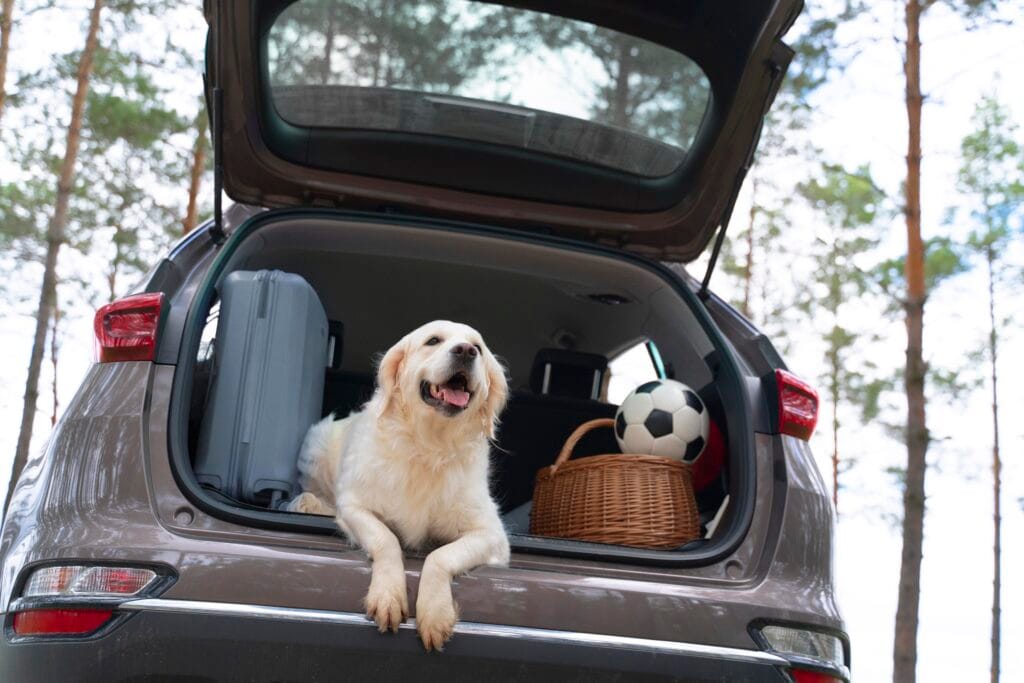Moving to a new home ranks among life’s most stressful experiences, and when you’re traveling with four-legged family members, the complexity multiplies. Your pets rely on you for their safety and emotional well-being during this transition. Whether you’re bringing an anxious cat, an energetic dog, or even smaller companions like rabbits or birds, the desert climate and unique characteristics of Tucson demand special attention to detail. Tucson Moving Service understands that your pets deserve the same careful planning as every other aspect of your relocation.
Preparing Your Pets Before the Move
The weeks leading up to moving day set the foundation for how well your animals will handle the transition. Start by scheduling a veterinary appointment at least three to four weeks before your planned departure date. Your vet can ensure all vaccinations stay current, provide health certificates if you’re moving from out of state, and prescribe anxiety medication if your pet has a history of stress-related issues. This visit also gives you the chance to request copies of medical records, which you’ll need when establishing care with a new veterinarian in your new neighborhood.
Gradually introduce your pets to moving supplies like cardboard boxes, packing tape, and storage containers. Animals often sense change in their environment, and the sudden appearance of dozens of boxes can trigger anxiety. Place empty boxes around your current home several weeks in advance, allowing your pets to investigate and become comfortable with these new objects. You might even catch your cat napping in an empty box, which actually helps them associate these items with comfort rather than stress.
Consider how you’ll transport your animals on moving day itself. If you’re driving to Tucson, plan your route with pet-friendly rest stops along the way. Flying requires different preparation entirely, including airline-approved carriers and specific documentation. For local moves within the Tucson metro area, the journey might be shorter, but desert temperatures still demand careful planning around the time of day you travel.
Understanding Tucson’s Climate Impact on Pets
Tucson’s desert environment presents distinct challenges that pet owners from humid or temperate climates might not anticipate. Summer temperatures regularly exceed 100 degrees Fahrenheit, and the intense sun can heat asphalt and concrete to dangerous levels. Dogs with sensitive paw pads can suffer burns from walking on hot pavement, while all pets face increased risk of dehydration and heat exhaustion.
The dry air affects pets differently than humans. Dogs and cats can become dehydrated faster in low humidity, and their water bowls evaporate more quickly than you might expect. You’ll need to check and refill water dishes multiple times throughout the day, particularly during the scorching months from May through September. Some pet owners find that investing in larger water bowls or even pet water fountains helps ensure their animals stay hydrated.
Desert wildlife adds another layer of consideration. Coyotes roam many Tucson neighborhoods, particularly near the foothills and in areas bordering natural desert landscape. These predators can pose a serious threat to small dogs and outdoor cats. Rattlesnakes, Gila monsters, and scorpions also inhabit the region, making it crucial to supervise outdoor time and keep your yard clear of debris piles where these creatures might hide. The Arizona-Sonora Desert Museum offers excellent resources about local wildlife and how to protect your pets from dangerous encounters.
Creating a Safe Space During Packing
The actual packing process can overwhelm pets who thrive on routine and familiarity. As your home transforms into a maze of boxes and wrapped furniture, your animals may exhibit stress behaviors like excessive meowing, barking, hiding, or even loss of appetite. Designate one room as a pet sanctuary where you postpone packing until the very last day. This space should contain their bed, favorite toys, food and water bowls, and litter box if you have cats.
Keep this room’s door closed during the chaos of packing activities. The constant foot traffic of family members carrying boxes, the noise of packing tape, and the general disruption can send even calm pets into an anxious state. Place a clear sign on the door reminding everyone that this room remains off-limits to packing activities. This sanctuary gives your pets a refuge where their environment stays consistent even as everything else changes around them.
When working with a professional moving company in Tucson, communicate clearly about your pet sanctuary room. Experienced movers understand the importance of pet safety and will work around your designated space. On moving day itself, this room becomes even more critical as movers load furniture and boxes onto the truck.
Moving Day Strategy for Pet Safety
Moving day brings maximum chaos and maximum risk for pets. The front door opens and closes constantly as movers carry items to the truck, creating numerous opportunities for an anxious pet to bolt outside. Even pets who never attempt to escape might panic with so many strangers in their home and dart through an open door. Have a solid plan in place before the first mover arrives.
The safest option involves removing pets from the home entirely during loading. Ask a trusted friend or family member to pet-sit at their house for the day, or board your animals at a reputable facility. If neither option works, keep pets secured in your designated sanctuary room or in a bathroom with the door closed and a prominent sign posted. Some pet owners use baby gates as a secondary barrier, though determined dogs might jump over them.
For those driving to Tucson, never leave pets unattended in vehicles, even for brief periods. The desert heat can turn a car into an oven within minutes, leading to potentially fatal heat stroke. If you must stop for gas or a quick errand, have another adult stay in the running vehicle with the air conditioning on. Better yet, plan your move for early morning or late evening when temperatures drop to more manageable levels.
Pack a dedicated pet essentials bag that travels in your personal vehicle rather than the moving truck. This bag should include food, water, bowls, medications, leashes, waste bags, a first aid kit, comfort items like a favorite blanket or toy, and copies of veterinary records. Having these items readily accessible means you can care for your pets immediately upon arrival without having to dig through sealed boxes.
Settling Into Your New Tucson Home
The first few days in your new residence set the tone for how quickly your pets adjust. Start by setting up a single room as a temporary base camp for your animals. Choose a quiet space away from the main traffic flow where you can place their familiar belongings. The scent of their own bedding, toys, and bowls provides comfort in an otherwise strange environment.
Introduce your home gradually, especially for cats, who tend to be more territorial than dogs. Let them explore one room at a time over several days rather than giving them immediate access to the entire house. This measured approach prevents them from becoming overwhelmed and reduces the likelihood of stress-related behaviors like inappropriate urination or excessive hiding.
Dogs typically adapt more quickly than cats, but they still benefit from structured introduction to their new surroundings. Walk your dog through each room on a leash at first, letting them sniff and investigate at their own pace. Once they seem comfortable indoors, begin exploring the yard together. Check your perimeter fence carefully for any gaps or weak points where a dog might escape, and scan for potential hazards like toxic plants, sharp objects, or areas where wildlife might enter.
Pet-Proofing Your Tucson Property
Desert landscaping often includes plants that pose risks to curious pets. Oleander, sago palm, and certain types of agave can cause serious illness or death if ingested. The ASPCA Poison Control website maintains a comprehensive database of toxic plants where you can verify the safety of vegetation in your new yard. If you discover dangerous plants on your property, remove them or fence them off until you can arrange for professional landscaping modifications.
Swimming pools are common in Tucson homes, offering welcome relief from the heat. However, pools present drowning hazards, particularly for dogs who might jump in but struggle to find the steps to exit. Install pool fencing if possible, and never leave pets unsupervised near water. Some pet owners teach their dogs where the pool steps are located through training sessions, which can be lifesaving in case of accidental falls.
The garage deserves special attention during pet-proofing. Antifreeze, which has a sweet taste that attracts animals, is extremely toxic and can be fatal even in small amounts. Store all chemicals on high shelves or in locked cabinets. Check for gaps under garage doors where small pets might squeeze through, and be hyperaware of your pet’s location before backing vehicles in or out of the driveway.
Establishing New Routines and Finding Resources
Pets thrive on predictability, so establish new routines as quickly as possible. Feed meals at consistent times, maintain regular walk schedules, and create bedtime rituals that mirror what your pets knew before the move. This consistency helps them understand that even though the location has changed, the structure of their daily life remains stable.
Begin researching local veterinarians before you even arrive in Tucson. Read reviews, check credentials, and call clinics to ask about their experience with your type of pet and any specific health conditions your animals have. Schedule a meet-and-greet appointment within the first week or two of arrival, even if your pet seems healthy. This establishes your relationship with the vet and ensures you have somewhere to turn if an emergency arises.
Tucson offers numerous resources for pet owners, from dog parks to hiking trails to pet-friendly restaurants and shops. The Reid Park area features off-leash dog parks where your pup can socialize and burn energy. Many restaurants along Fourth Avenue and in downtown welcome dogs on their patios, helping you integrate your pet into your new social life. However, remember that hot pavement can burn paws, so stick to early morning or evening outings during summer months.
Watching for Signs of Stress and Adjustment Issues
Monitor your pets closely during the first several weeks in your new home. Changes in appetite, bathroom habits, sleep patterns, or behavior can indicate that your animal is struggling with the transition. Some stress responses are normal and temporary, like a cat hiding under the bed for the first few days or a dog seeming clingy and anxious. These typically resolve as the pet becomes familiar with the new environment.
More concerning signs include prolonged refusal to eat, aggression toward family members, destructive behavior, or elimination outside the litter box or designated bathroom area. If these issues persist beyond a week or two, consult with your new veterinarian. Sometimes anxiety medication or pheromone diffusers can help pets through difficult adjustment periods. Behaviorists can also provide strategies tailored to your specific situation.
Outdoor cats face particular challenges when adjusting to new territory. Many experts recommend keeping cats indoors exclusively for at least two to four weeks after a move, giving them time to bond with the new home as their territory. When you do begin allowing outdoor access, start with short supervised sessions and gradually extend the time. This approach reduces the risk of your cat attempting to find their way back to your old address.
Special Considerations for Different Types of Pets
While dogs and cats get the most attention in moving advice, households with birds, reptiles, small mammals, or fish face unique challenges. Birds are extremely sensitive to stress and temperature changes. They need their cage covered during transport to reduce visual stimuli, and they cannot tolerate temperature extremes. Never place a bird cage in direct sunlight, and ensure adequate ventilation during transport.
Reptiles require careful temperature regulation, which becomes particularly challenging in Tucson’s extreme climate. If you’re moving during summer, transport them in insulated containers with temperature monitoring devices. Some species need heating elements, while others require cooling. Research the specific needs of your reptile species and plan accordingly, as improper temperature during transport can be fatal.
Small mammals like rabbits, guinea pigs, hamsters, and ferrets need secure carriers with adequate ventilation. Line carriers with absorbent bedding and include a small amount of their regular food. These animals can become dehydrated quickly, so offer water-rich vegetables during longer journeys. Keep carriers out of direct sunlight and in climate-controlled environments at all times.
Aquarium fish present perhaps the most challenging relocation scenario. For local moves, fish can sometimes remain in partially filled aquariums with battery-powered aerators. Longer distances require transporting fish in sealed bags with oxygen, similar to how pet stores package them. Research proper bagging techniques or consult with local aquarium shops about professional transport services. Never transport aquarium decorations and substrate with water still in them, as the weight makes them dangerous to lift and the sloshing can cause damage.
Making the Move Easier with Professional Help
Relocating represents a massive undertaking even without pets in the equation. Professional movers bring expertise, equipment, and efficiency that can significantly reduce your stress level, which in turn helps your pets remain calmer. When you’re not exhausted from carrying heavy furniture and countless boxes, you have more energy to devote to helping your animals adjust.
Experienced moving companies understand the challenges pet owners face and can work around your needs. They can load the truck quickly and efficiently, minimizing the time your home remains in chaos. They can also unload and place furniture in your new home according to your instructions, allowing you to set up your pet’s safe space immediately rather than having to move heavy items around later.
Clear communication with your moving team makes the entire process smoother for everyone, including your pets. Explain where you want items placed, point out any areas that need special care, and don’t hesitate to ask questions. Professional movers have seen it all and can often offer practical solutions you might not have considered.
Long-Term Adjustment and Building a Life in Tucson
The transition period doesn’t end after the first week or even the first month. Some pets adapt quickly, while others need months to fully settle into a new environment. Be patient with setbacks, maintain consistent routines, and celebrate small victories. The day your anxious cat finally comes out from under the bed to play, or when your dog stops pacing nervously and flops down for a relaxed nap, you’ll know progress is happening.
Tucson’s pet community offers numerous opportunities to build a new life that includes your animals. Training classes provide mental stimulation for dogs while helping you meet other pet owners. Hiking groups specifically for dog owners explore the beautiful desert trails around the city. Supporting local animal shelters and rescue organizations through volunteering or donations helps you give back to the community while surrounding yourself with fellow animal lovers.
The desert environment might seem intimidating at first, but with proper precautions and planning, pets can thrive in Tucson. The mild winters allow for year-round outdoor activities, and the city’s generally pet-friendly culture means you’ll find welcome signs at many businesses and public spaces. Your pets will discover new favorite spots to explore, from desert washes to mountain foothills, creating fresh memories in your new home.
Planning a move with pets requires extra thought and preparation, but the effort pays off when you see your animals settled and content in their new surroundings. From the initial planning stages through the first months in your new home, keeping your pets’ needs at the forefront of your decisions ensures their safety and well-being. With patience, preparation, and the right support, both you and your pets can make a successful transition to life in Tucson.



